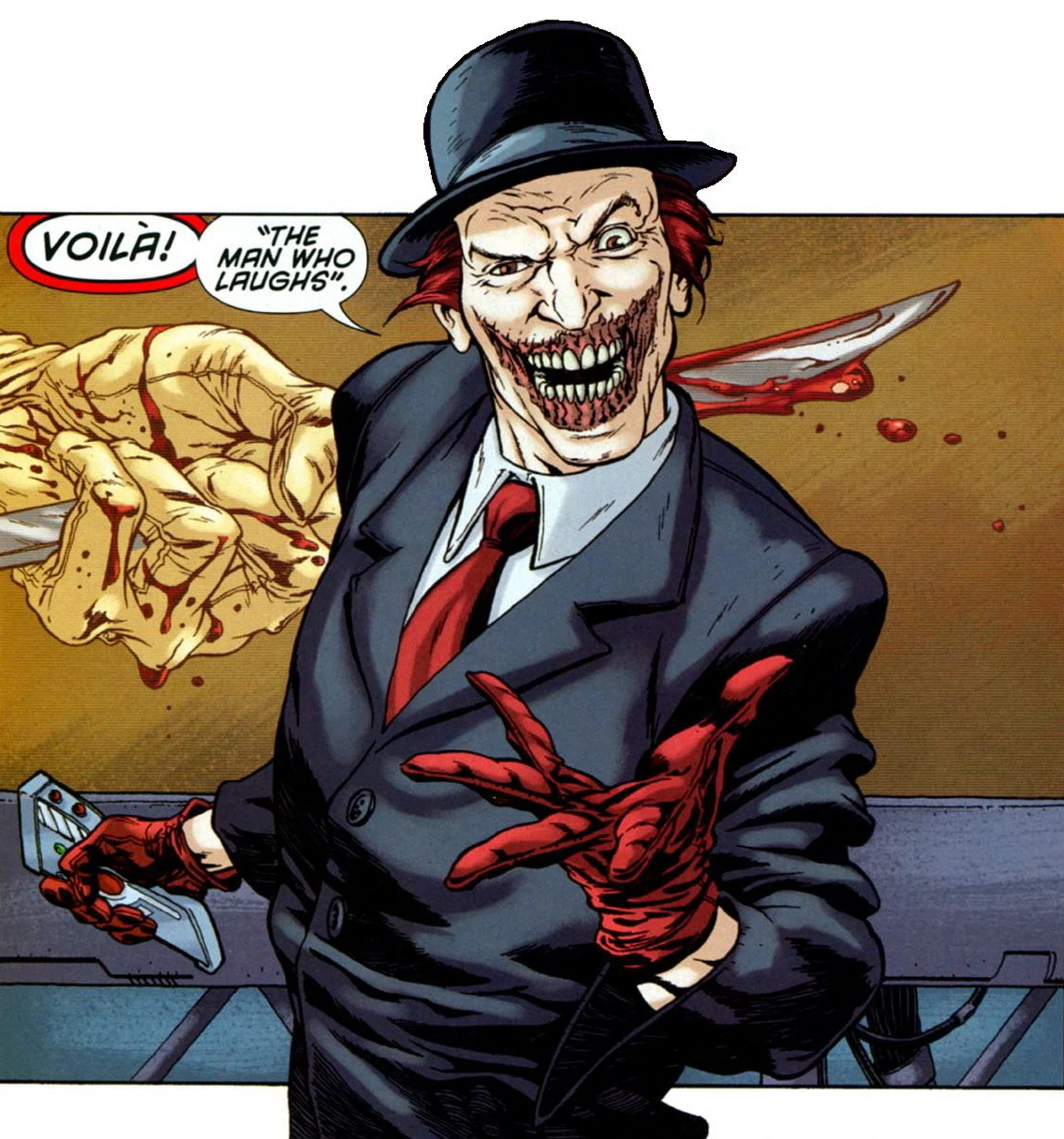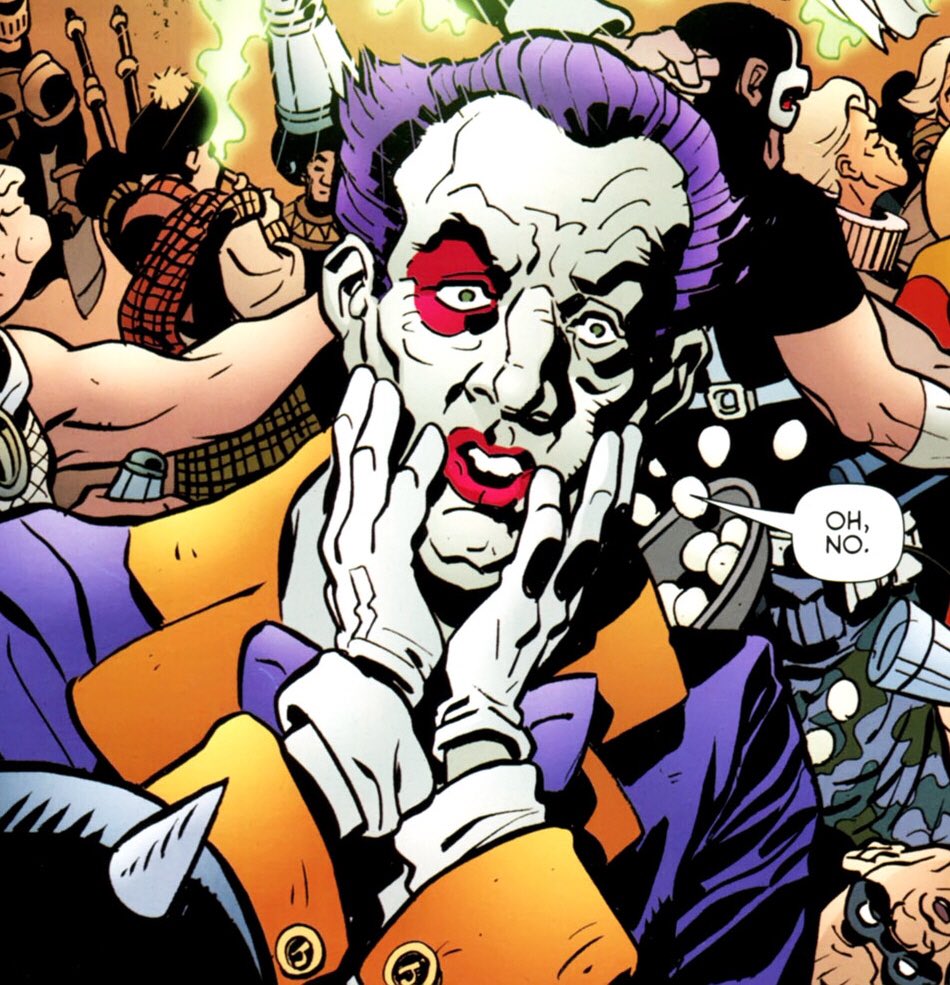While the Joker is the one and only Clown Prince of Crime, he is also a cultural phenomenon, ensuring that clones of supervillains will emerge to bask in his reflected glory. One such impersonator is The Man Who Laughs.
Norman S. Rotrig, aka The Man Who Laughs, hails from France and is affectionately known as the French Joker. His backstory, however, is far more intricate than merely being another Joker clone. Norman’s father wore a perpetual grin on his face, similar to how the Joker damaged his own.
As a result of his sorrow and suffering, Norman developed into a surrealistic criminal. Norman deconstructs his victim, putting their connected organs in many vats designed to keep them alive as long as possible at a hidden facility that perhaps not even the World’s Greatest Detectives would ever discover, embracing his father’s proclivity for making people into works of art.
Norman Rotrig Tragic Origin Explored

Norman Rotrig, known to fans as the Man Who Laughs, is synonymous with The Joker in France and he is also one of the main adversaries of the Nightrunner. Norman has a tragic origin story, which begins from the very day he was born. His mother died during childbirth. After his mother died, Norman had been raised by his father. As his father became infatuated with Victor Hugo’s works, he sought to make living art out of his son.
His father was a mad artist, and he took his tiny baby and made the child into the artwork by cutting his lips away, and ensuring that a permanent “smile” was plastered onto his face, which is very reminiscent of the way the Joker removed his own face. When he became an adult, Norman decided to exact sweet revenge on his father by cutting him up into multiple tiny pieces and storing all of them in glass boxes, all while ensuring he stayed alive and making him watch the family’s home movies on a loop so that he could reflect on the way he treated his son.
It is likely that the machines keeping his father alive would go on to work long after the Joker’s and even Batman’s death. During this time, Nightrunner, Robin, and Batman were attempting to look for Rotrig.
The Nightrunner, whose real name is Bilal Asselah, is a free, unattached vigilante who roams the streets of Paris. He is also a member of Batman Incorporated. Bilal is actually a student in the Paris neighborhood of Clichy-Sous-Bois, a tense area marked by racial conflicts. Bilal declined to take a side in the dispute until he and his best buddy Aarif were caught up in the middle of it one day.
Later during the day, Aarif, preoccupied with seizing control of the law, burned down a police station, killing himself in the process. To commemorate his friend’s memory, Bilal resumed his Parkour training and went on to become the superhero dubbed Nightrunner to avert anarchy and civil strife in his city.
Rotring wishes to compel the three superheroes to look for him, and in order to reach his objective, he sets free four of the city’s most deranged villains from jail and takes a gas bomb in front of his head, so as to make him seem like “The son of man.”
The Batman and Robin comic issue number 26 narrates Rotrig’s story in great detail. The issue starts off with Rotrig narrating his childhood and how he was a young and healthy baby, which he knew because his father made a lot of home movies since his childhood. His father has grand plans for Norman and believes that he is destined for greatness. The scene switches to Batman, Robin, and Nightrunner standing at a place that was once The Louvre.
It turns out, that there has been a breakout in Le Jardin Noir, which is called The Black Garden in English and is the French equivalent of Arkham Asylum. Rotrig is the one who helps the prisoners escape by numbing the security guards with nerve gas and freeing Sister Crystal, The ID, Ray Man, and Skin Talker. Sister Crystal can turn any organic material into a substance resembling glass. But our superheroes have many other problems on their hands, as they are attacked by a swarm of innocent residents who have lost control of their minds.
Batman instructs the heroes to try to not hurt any of them. The escaped inmates are practicing some form of mind control, which is inducing violent behavior in the civilians and causing a riot. The ID has the power of empathy and can make people act on their secret desires, which is what is causing this; he can also secrete pheromones that heighten primal urges and weaken inhibitions. He is also sister Crystal’s lover and is unstable as she turns his skull into a glass to see the inner workings of his mind.
The skin talker can make words appear on his skin, and he used to use them to predict the future, until eventually, people realized they didn’t read the future, but instead delivered post-hypnotic suggestions. The superheroes make quick work of the bad guys and are about to leave when suddenly, it seems that Sister Crystal turns Robin into a glass and he shatters.
The world seems to be moving strangely around them and all the superheroes are very confused as to why this is happening when Paradox, The Ray Man appears. He can make the laws of science and nature bend to his whim. But whatever he creates is an illusion and is not real. The heroes take him down by closing their eyes and concentrating on their bodies, all the while remembering that everything, he creates is an illusion.
They sedated him and the others with a dose of concentrated Xenon before taking them back to the Black Garden. The heroes realize that Rotrig is watching them the entire time, and go ahead and demand answers from him. The French Joker has set up explosives, and so the heroes cannot sedate him and he forces them to watch a home movie of when he was a child. He reveals to them his face and tells them he was his father’s work of art.
Norman says he did all this because he wanted to create art and he believes it is reasonable for people to die for art. Batman becomes enraged and attempts to get the remote in his hand, but Rotrig reveals that the explosives are voice-activated and sets them off by saying “Goodbye, father.”
The explosives turn out to be a bit of a bust as they were never meant to kill, and Rotrig also reveals to the superheroes that he is transmitting the live video of whatever is going down to his father who is stored inside many glass boxes, while a machine is keeping him alive. Norman believes that in the end, his father will learn that there is nothing to learn and all of the accomplishments men make and all of our great civilizations are nothing but a dance of fools.
What Makes Norman Rotrig So Dangerous?

Norman Rotrig is not just evil, twisted, and possibly clinically insane, but he is also an excellent chemist and has a vast knowledge of chemistry. All his grand schemes and great “artwork” could not have been created without his in-depth knowledge of Chemistry and science. Medicine, sometimes known as surgery, is the art and science of healing or sustaining health. Medicine is known to be the use of medications, surgical procedures, equipment, and obstetrics to treat people, and Rotrig is an expert at it.
It is using this power that he is able to keep his father alive even when his organs are separate for many years to come. Science is a word that we can use to characterize Norman Rotrig’s capacity to utilize his brain in a given topic to academically and practically comprehend research. It is sometimes considered evidence of “genius-level intelligence.” It is up to him whether to study behavior, comprehend an idea, or actively use his knowledge. The investigation, often known as analysis, is a phrase we can use to define Norman’s capacity to apply logical reasoning to reach a conclusion.
Norman is also talented in Gadgetry, and he employs his skills to make and uses amazing devices for a variety of purposes. He, in particular, has a tendency to utilize his powers offensively, and he also loves to theme his creations and term them as works of art. Rotrig also suffers from a number of mental diseases that force him to suffer in his daily life. These include behavioral or chemical dysfunction, aberrant disorders, extreme anxieties, chemical dependency, and drug exposure that affects his cognitive process and behaviors.
Conclusion

The crimes committed by The Man Who Laughs are cruel, theatrical, and darkly sarcastic, with all the markings of a brilliant, though unsettling, Joker storyline. The Joker’s appeal as a villain is that he is most fascinating when his misdeeds are directed at a single individual, much the same as Norman’s to his own father. Norman is constantly focused on getting revenge from his old man and comes up with various devices and schemes in order to do so.
His entire life mission, possibly, is to create a work of his version of art that is grand or impressionable enough to erase the trauma that his father put him through when he was a young boy. The Man Who Laughs successfully personifies the Joker, releasing a personality and ingenuity reserved for the finest horror fiction.
